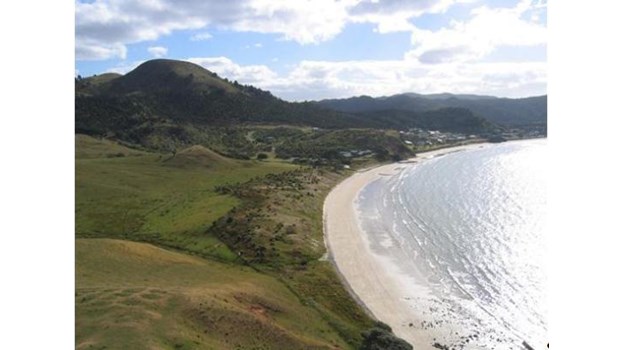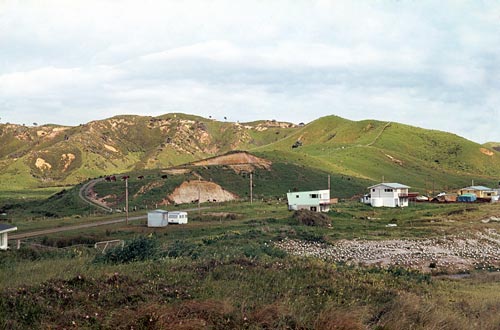Tahanga Hill
For comprehensive information relating to this Category 1 historic place entry on the New Zealand Heritage List (List No. 9419), please consult the report at Search the List | Tahanga Quarries | Heritage New Zealand which provides the very latest information about the List entry. There is a separate List entry for a wāhi tapu at Tahanga (List No. 9589), some information about which is at Search the List | Tahanga | Heritage New Zealand .
Tahanga Quarries was the most important source of basalt for the creation of stone tools in New Zealand during the first centuries after human arrival. Located at the eastern end of the Kuaotunu Peninsula in the Coromandel, it forms part of an important landscape linked with early settlement in New Zealand and reflects significant connections with East Polynesian culture. Tahanga’s main products were adzes, used for timber felling and woodworking, and perhaps particularly canoe manufacture. The adzes were distributed throughout northern New Zealand, where they are found in some of the country’s earliest known archaeological sites.

Tahanga Quarries is situated on the summit and flanks of Tahanga Mountain, extending north to the shore of Opito Bay. It lies within a notable area of early occupation on the Kuaotunu Peninsula and broader Coromandel, which includes settlements at nearby Sarah’s Gully and Skippers Ridge, and on Ahuahu or Great Mercury Island, nine kilometres to the north. Quarrying appears to have been underway at Tahanga by the early fourteenth century, when its adzes were being used as far afield as Houhora in the Far North. Stone was quarried mostly from boulders on the site, although a lava flow in the intertidal zone was evidently also utilised. The main production at Tahanga appears to have been the creation of rough adze preforms on working floors within the complex. ‘Finishing centres’ to complete products through further flaking have been found both nearby and up to 60 kilometres away.
The adzes sourced from Tahanga were ‘side hafted’ and of gripped quadrangular form. Similarities between early adzes such as those from Tahanga and those produced in Eastern Polynesia suggests direct contact between New Zealand and other Pacific communities. Comparable basalt quarry sites in the Pacific include those at Tataga Matua in Samoa and Mauna Kea in Hawaii. Tahanga’s significance as a stone source to Maori can be seen in its inclusion in an oral tale which describes how Poutini, a guardian taniwha protecting the mauri or spiritual essence of greenstone, lit a fire on the beach before travelling on to other locations of value for their stone products. The account effectively provides a map of stone resources in New Zealand, and has been described as the country’s first ‘geological survey’.
The quarries are likely to have declined by the sixteenth century, although limited production may have occurred into the 1700s. A pa was established on the summit of Tahanga Mountain, believed to have been associated with some ongoing work. The area formed an important place of refuge for Ngati Hei during inter-tribal conflicts, in this latter period and was part of its turangawaewae following incursions in the early nineteenth century. Obtained by the Crown in 1860, the land was subsequently transferred into private ownership and utilised primarily for farming. Since the 1960s, Opito township and associated housing has developed in the immediate vicinity. Most of the site remains in private hands, and is used for a combination of pasture and forestry.
Tahanga Quarries has high archaeological significance as a well-preserved and a rare type of archaeological site containing extensive evidence about early quarrying and stone tool production in New Zealand. It has cultural value for demonstrating early links with other communities in the Pacific. It has historical significance for its close associations with the early settlement of New Zealand, and for reflecting the importance of industrial activity in the first few centuries after human arrival. Tahanga Quarries has scientific value for its ability to provide information about the past through methods such as the geochemical analysis of its basalt and basalt products. It has technological value for demonstrating important aspects of tool production, including the application and adaptation of technologies used elsewhere in the Pacific. The place has traditional value for its connections with Poutini and related individuals in traditional history, which reflect the importance of Tahanga as a stone source to Maori.
Skippers Ridge

Skippers Ridge, in the background of this photo from the mid-1970s, was – along with nearby Sarahs gully, out of the picture to the right – the site of archaeological excavations in the late 1950s which first found evidence of early Polynesian settlement in the North Island. The seagull-covered dunes in the foreground are the site of a midden – rubbish dump – of shells and other materials of archaeological interest.
